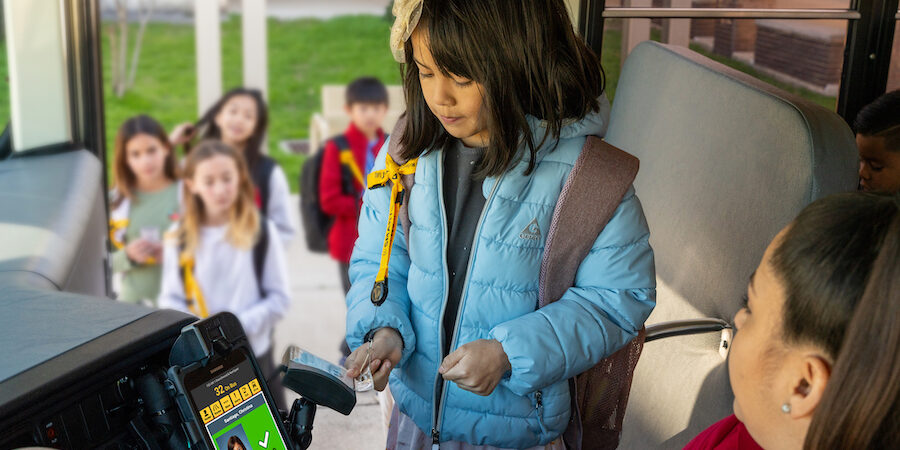With a widespread shortage of school bus drivers and rising costs, student transportation has become a source of stress for many districts. That’s on top of liability issues inherent to transporting so many children for many miles, introducing opportunities for mix-ups like mistaken drop-offs. In the U.S., about 26 million students travel to and from school on around 480,000 school buses — and those buses cover a cumulative billion miles every year.
Managing student transportation: A growing challenge for K-12 districts
Orchestrating the transportation of students, even in a small school district, can be a complex juggling act. School administrators often struggle to monitor bus routes, keep track of which students are on which bus, ensure safety at student bus stops and student transportation safety during the ride, and manage field trips and class excursions. Many bus drivers and administrators rely on paper-based systems to manage student lists and keep track of their whereabouts. But it’s a constant struggle to keep loose-leaf binders and paper clipboards updated with the latest student information, meaning drivers — and parents — may not be well informed.
Another area of challenge for bus drivers is student referrals. When a driver wants to report a student’s behavior — because of a discipline issue, a concern, or a commendation — they must take time to fill out a paper form and submit it to administrators. Often, the drivers never receive a response and the situation may go unresolved, lost in other paperwork.
SMART tag and Samsung: A viable solution
In an effort to provide a safe, secure means of transporting students from home to campus and back again, some school districts are turning to technology tools like SMART tag. Created in 2014 by a school bus driver in Texas who wanted to give schools the tools they need to increase student transportation safety and provide better communication between all stakeholders, the solution combines an onboard tablet with RFID tags carried by each rider. Students scan their tags as they board the bus and the software ensures that they are authorized to ride. When a student leaves the bus, they scan the card again to make sure it’s the correct stop. The solution combines data collected via RFID tags with GPS data from buses, providing a streamlined way for school districts to monitor their transportation systems — and for parents to easily see where their child is at any given moment.
Through a partnership with Samsung, the solution utilizes a resilient tablet, Samsung Galaxy Tab Active5, for data management on board a district’s fleet of school buses. “When we launched in 2013, we were on a consumer-grade tablet, but soon realized it wouldn’t last long in the school bus environment,” said Noel Lopez, director of operations at SMART tag. “By contrast, the Tab Active5 is powerful, rugged, has RFID scanner and cellular capabilities, and supports all major cellular carriers in the U.S. It’s a great platform for our solution.”
Transform the educational experience
Get your free guide to using and managing Chromebooks in K-12 schools. Download Now
The system provides live monitoring of students’ location to keep administrators and parents informed. All data is encrypted and secure, accessible only to approved individuals through the cloud-based web portal. With Samsung Knox Suite, district administrators can manage tablets on school buses easily and deploy new tablets quickly. “We appreciate knowing Samsung hardware is secure, from the chip up,” Lopez said. He also values the partnership in terms of technical support. “When we’ve had challenges or roadblocks along the way, we’ve been able to reach out to Samsung to help overcome those challenges. It’s been good to have a channel to communicate — and the resources on their side to provide suggestions for us.”
Revolutionary results: The SMART tag solution in action
Currently, more than 100 school districts throughout the U.S. use the SMART tag solution to monitor student transportation. Douglas County School District in Colorado previously used another tracking system that did not incorporate a tablet on the buses. Since adopting the SMART tag, administrators have reported a dramatic positive change. “Parent notifications of route changes or delays are nearly effortless using SMART tag features, and route optimization is made easier with robust student ridership data and GPS time tracking,” said Jeff S., Highlands Ranch terminal manager in the Douglas County School District. “Student load and unload is relatively quick and painless — and the ease of use from the administrative side is superior.”
At North Thurston Public Schools in Washington State, administrators and drivers have embraced the SMART tag solution. “SMART tag has become a foundational piece to everything we do,” said Garrett K., transportation director at North Thurston Public Schools. “From student and route tracking to logging pre- and post-trips and processing student referrals, it’s the most valuable tool we use daily.”
It’s not easy to create a smart solution resilient and powerful enough to manage a fleet of school buses, track several streams of data, and facilitate quick and streamlined communication between bus drivers, school administrators, and parents. With Samsung hardware and device management software providing the building blocks, SMART tag has tackled that challenge and created an innovative, tailored solution to ease the burden of K-12 transportation.
Discover more education technology from Samsung that can enhance your students’ remote learning. Sign up now for a Samsung Business Account and gain access to exclusive offers.








